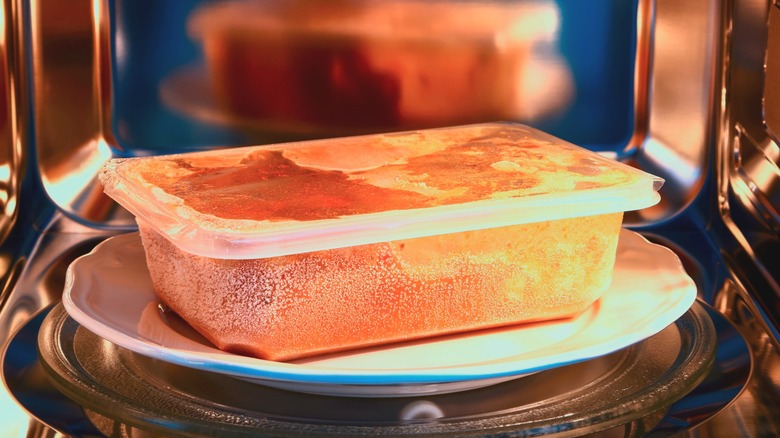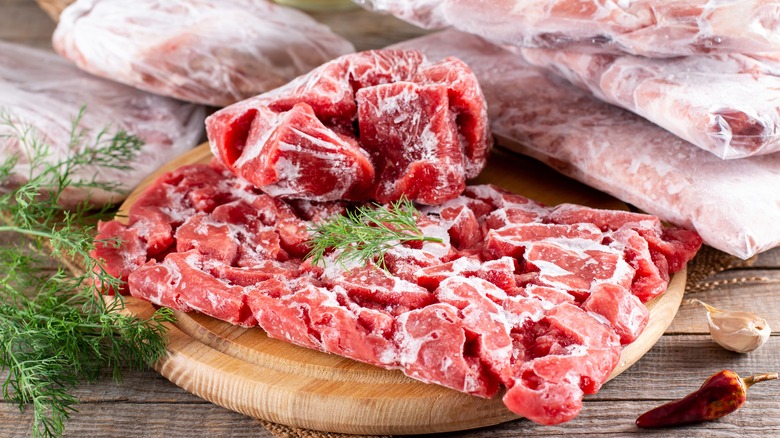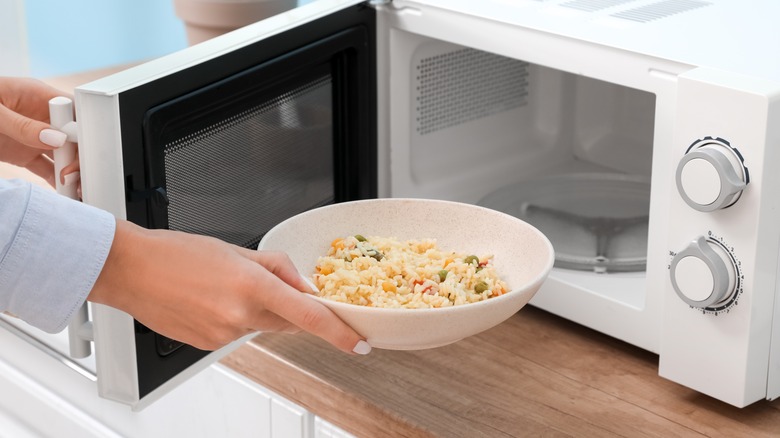Why You Should Think Twice Before Defrosting Food In The Microwave
How many times has a microwave come to the rescue when you've forgotten to take out frozen meat and thaw it in the refrigerator hours before cooking? The handy appliance can defrost food in a matter of minutes, making it seem like a microwave cooking hack that you'll wish you knew sooner – but while the USDA considers microwaves to be a safe way to thaw food, and some models even come with specific defrost settings, not all is as easy as it seems. Defrosting food in this appliance can be trickier than expected, which is why you might want to think twice the next time you do so.
For starters, microwaves are notorious for heating food unevenly, and that applies to defrosting too. There are several reasons why this might happen. One possible explanation is that some elements inside your food have a lower water content, which causes them to absorb more heat and defrost faster than others. The way the food is arranged on a plate can play a role too, as can the settings of the microwave. Sometimes, the culprit could even be a faulty appliance.
Regardless of the cause, unevenly-defrosted food can be a safety concern, and you might find that your food has thawed perfectly from the outside, but is still rock-hard frozen in the middle. The unsafe aspect has to do with the so-called "Danger Zone."
Microwaves can raise the temp of frozen food to unsafe levels
The USDA classifies temperatures between 40 and 140 degrees Fahrenheit as the Danger Zone for food, in which bacteria such as salmonella and E. coli can swiftly multiply, reaching dangerous levels after two hours. Refrigerators defrost foods whilst keeping them at a cool and constant temperature of 40 degrees Fahrenheit or lower, which is why they are one of the safest and best ways to thaw food, especially frozen meat.
Meanwhile, a microwave warms frozen items enough for their temperature to reach higher than 40 degrees Fahrenheit, but without fully cooking them to destroy harmful bacteria. This means that your items end up partially cooking to a temperature that falls squarely in the Danger Zone. It's also why thawing in hot water or at room temperature is a huge no-no, as both of these methods will leave your foods at unsafe temperatures.
Although microwaves at a defrost setting normally function at 20% to 30% of their usual power to prevent the food from cooking, their tendency for uneven heating does not help. Some parts of your food may reach temperatures between 40 to 140 degrees Fahrenheit, while others still look like they could do with a few more minutes. To be safe, only defrost ingredients in the microwave if you plan to cook them immediately. If not, refrigerators are a much safer option, as they can keep thawed foods fresh for a couple of days before you cook them.
How to safely defrost food in the microwave
There are certain safety tips that will ensure a better defrost if you absolutely must use the microwave. For one, always spread out the frozen items evenly and lay them flat on a microwave-safe plate or bowl. Piling items will only make the thawing more inconsistent. Always flip solids and stir liquids about halfway through the process, whilst also rotating the container and breaking up any large lumps. All of this will help distribute that heat more uniformly through the food.
Fruits and vegetables only take two to three minutes to thaw, whereas frozen liquids can take a couple more. Meat requires a little more calculation. While the exact time will vary depending on the wattage of your appliance, a 1,000-watt microwave takes eight to 10 minutes to defrost each pound of meat. Add those minutes based on how many pounds of food you're thawing, and set the timer accordingly.
That said, consider defrosting less than two pounds of meat in one go when using a microwave. Any more, and the meat will have a harder time thawing properly, leaving you with frozen centers and cooked outer layers. It's also wise to avoid tender proteins like fish or small veggies like peas: These go from frozen to cooked in a microwave, completely skipping past the thawed stage. Consider dousing them in some cold water instead, or just cooking them directly (you can even cook frozen chicken without thawing it first).



